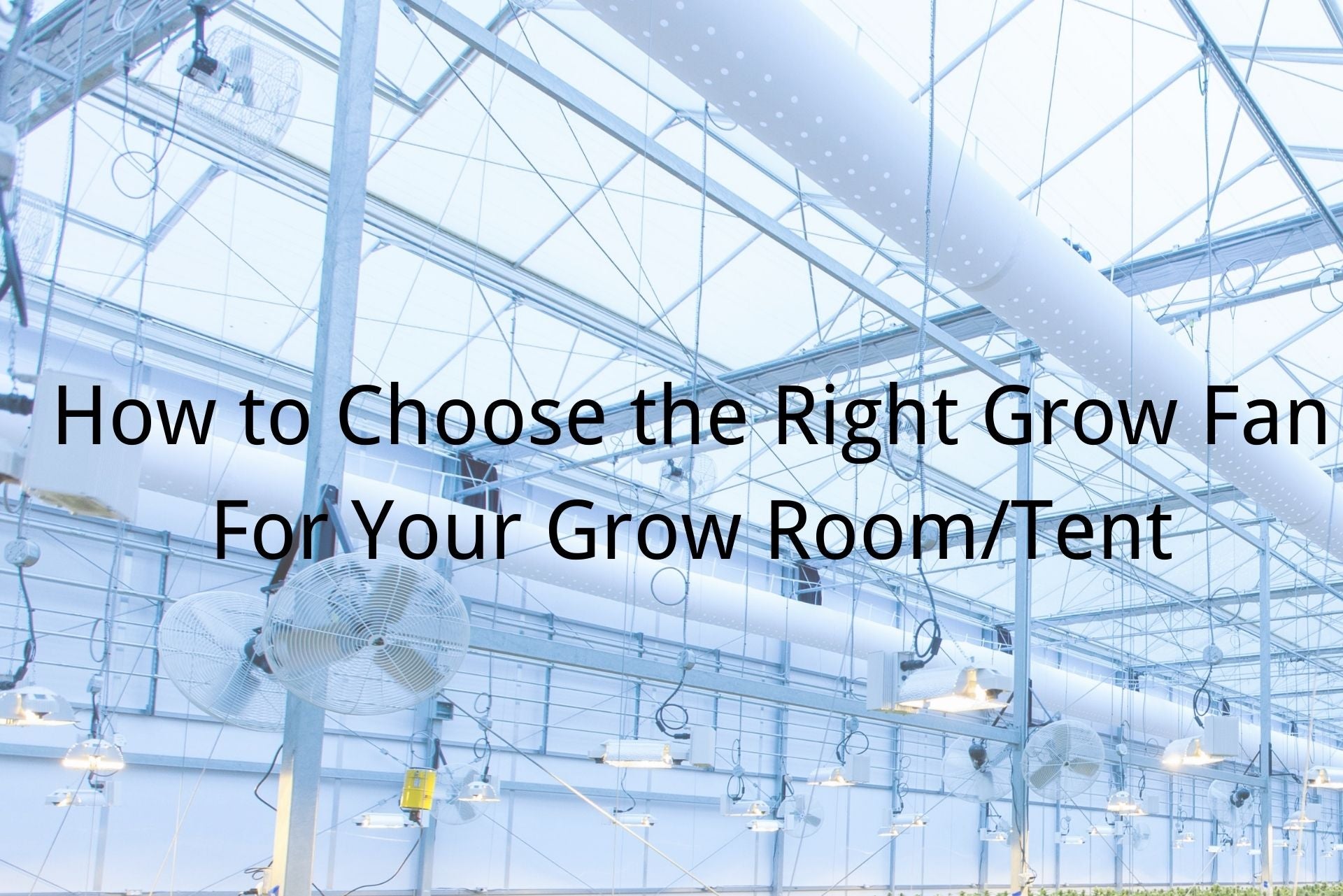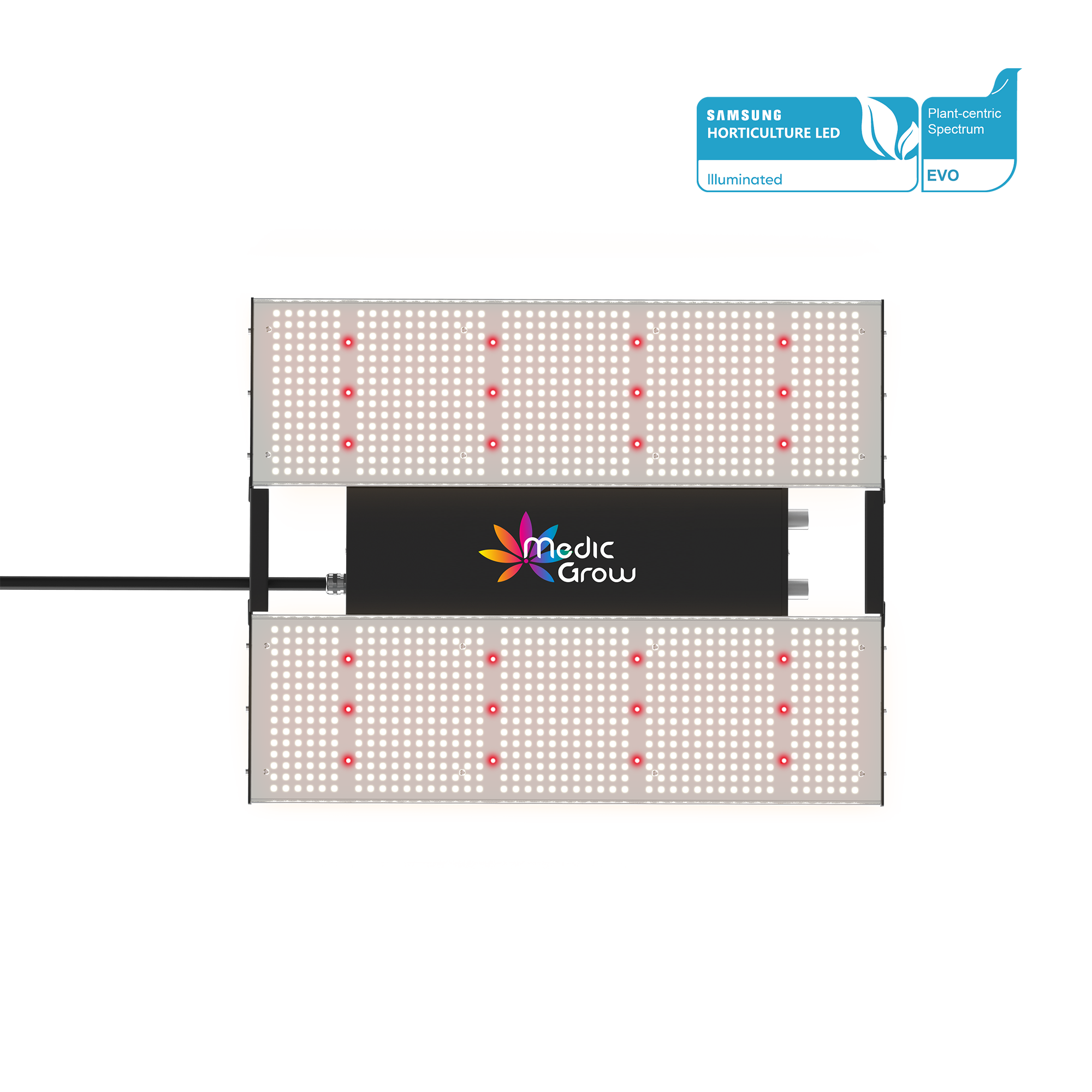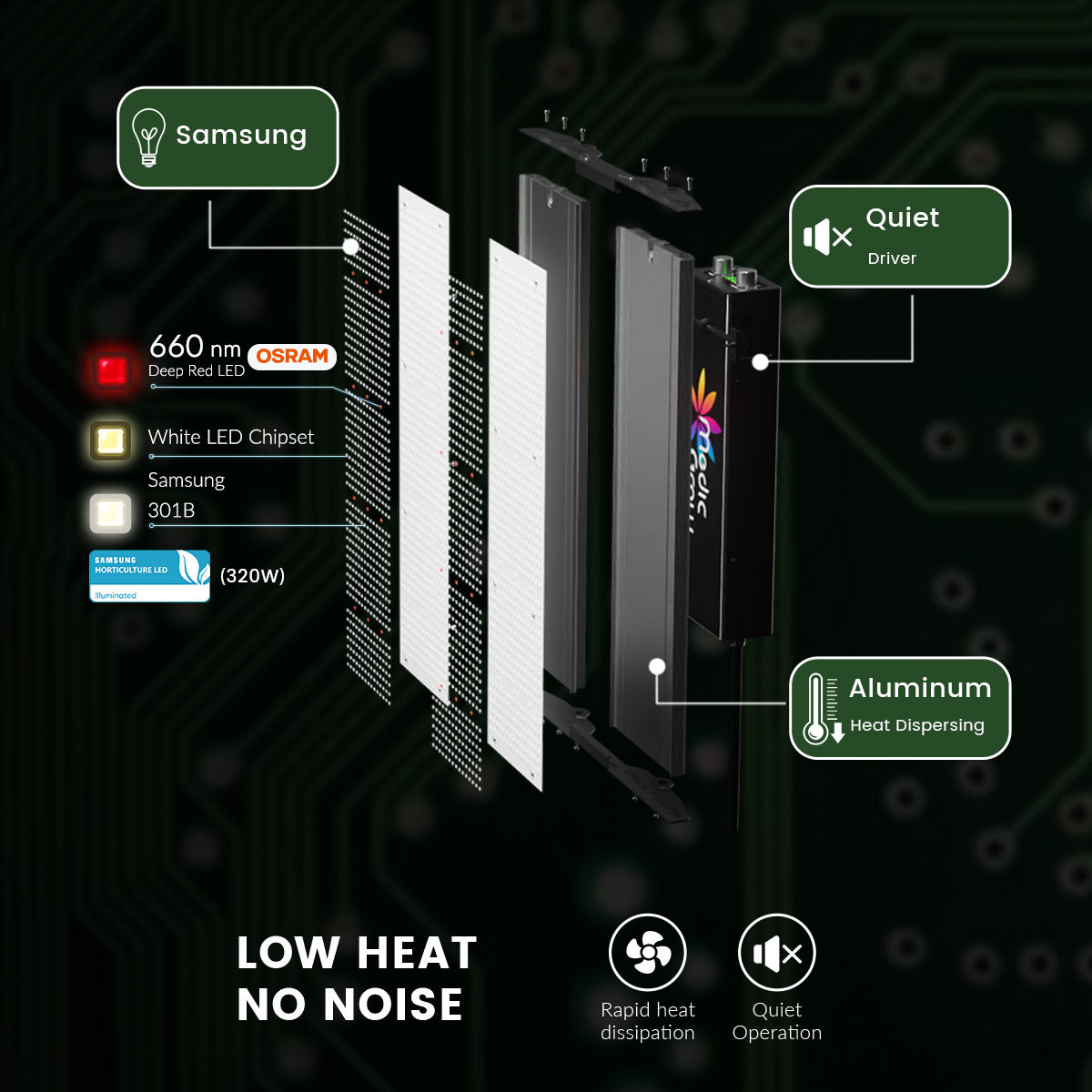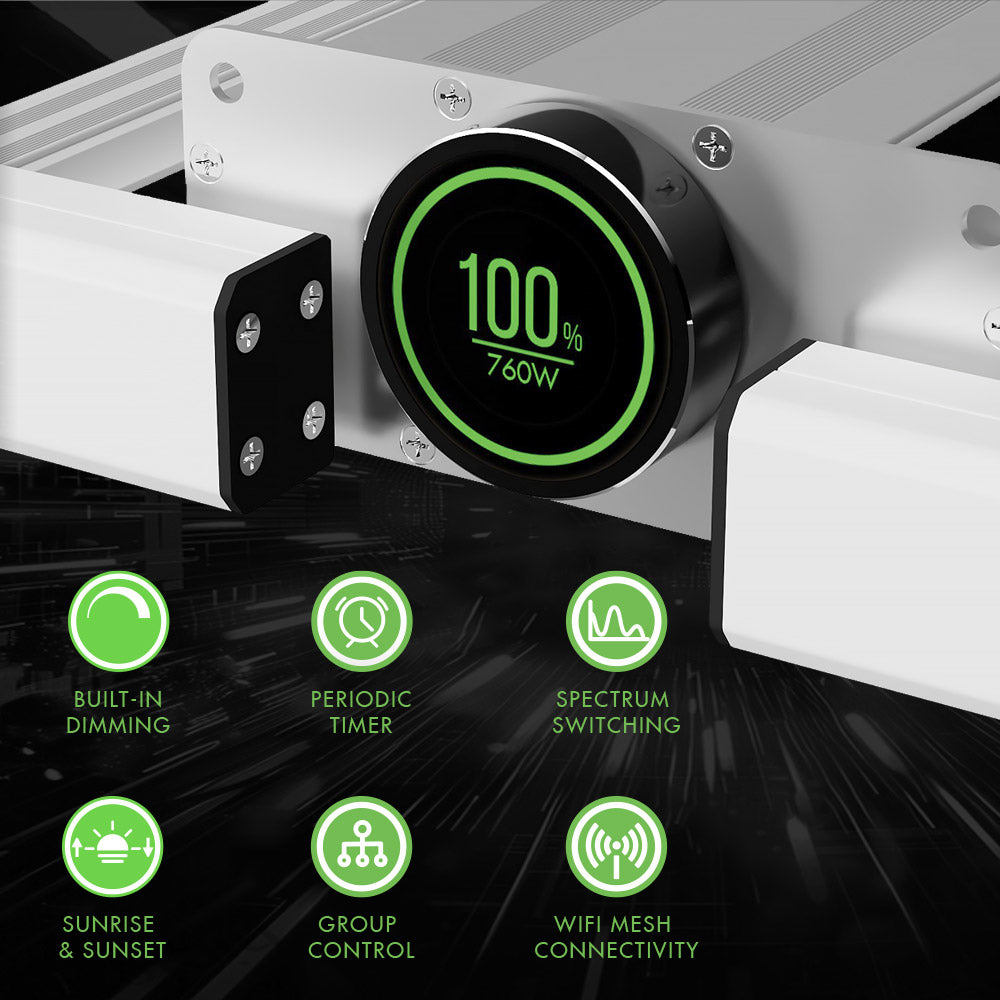
How to Choose the Right Grow Fan for Your Grow Room/Tent
If you are building your grow room or thinking about it, you might have heard about grow light, grow fan and ventilation systems for a grow room.
Beginners might get confused about the use of a grow fan or multiple fans inside a grow room, and they might be skeptical whether they should install fans or not. Therefore, we are here to discuss this topic in detail.
We will discuss why you need grow fans, the common types, and how you can choose the right grow fan for your grow tent/room. Let’s start the discussion.
- Part 1: Why Do You Need Grow Fans?
- Part 2: Different Grow Fan Types You Should Know
- Part 3: Tips to Choose the Right Grow Fan for Your Grow Room/Tent
Why Do You Need Grow Fans?
Grow fans are essential for a grow room because of various reasons.
Beginners might think it is only for ventilation. Of course not! Grow fans have various advantages, and it helps in overcoming multiple grow room issues.
Let’s see why you need to use grow fans inside your grow room.
Grow Fans For Ventilation
The apparent or first reason for installing grow fans is ventilation. Fans circulate the air and replace the inside air with fresh air.
Ventilation is not only necessary for workers in the grow room, but it is also essential for the growth of indoor plants and their yield.
Plants need water and carbon dioxide in the presence of light to produce their food. Thus, carbon dioxide is one of the main ingredients for the process of photosynthesis.

Plants take carbon dioxide from the air present in the grow room. Due to the consumption of carbon dioxide, its concentration decreases with time, and in the end, there is limited carbon dioxide left for photosynthesis.
If the concentration of carbon dioxide is low, then plants cannot produce their food, and it will affect the yield. In severe cases, plants may die.
Thus, it is necessary to intake fresh air and expel the present air from the room. It ensures the optimal concentration of carbon dioxide to carry out photosynthesis and improve the yield. With the help of grow fans, a fresh supply of carbon dioxide is always available.
Grow Fans For Temperature Control
The second reason for installing fans is temperature control. You might be thinking about how air circulation can control the temperature and why it is necessary.
Due to full-spectrum grow lights, the temperature inside the grow room increases with time. These lights produce heat that accumulates in the air; consequently, the temperature is increased.

Different types of grow lights are available, such as 800W LED grow lights, CFL, incandescent lights, and HID. All these types of light emit heat which increases the temperature. However, LED lights are very efficient, and they emit minimal heat compared to other types.
Now, it is clear that the temperature increases with time. Due to the rise in temperature, there can be various issues. The water given to plants might dry out quickly and cause water deficiency.
Plants also need a suitable temperature to offer optimal yield, and if the temperature is higher than the expected range, the yield can be affected.
Fans also help in reducing the temperature and blending the air in the grow room. They expel out the air and take fresh air inside the room. This ventilation process maintains a suitable temperature inside the grow area.
Grow Fans For Humidity Control
Humidity control is quite essential when it comes to indoor grow rooms. If it is not controlled, it can lead to various problems.
High humidity is a favorable condition for the growth of insects and pests. These harmful living organisms are detrimental to plants. Due to high humidity, plants also absorb more water, which is not favorable for the yield.
Humidity increases in the atmosphere because plants transpire. The water of transpiration mixes in the air, and the water that we give to plants also increases the humidity. Therefore, humidity control is essential.
The effective way to control humidity is using fans. The exhaust fans expel the humid air, and the intake fans take fresh air. It maintains the humidity level of the area.
Odor Control Also Needs Grow Fans
Indoor grow fans also play an important role in odor control.
Most of the plants in the indoor grow room produce an odor, and the intensity depends on the type of the plant.
The odor accumulates in the air, and the concentration increases with time. Therefore, you need to expel the odor out of the room.
The exhaust fan expels the odor out of the room, but it can irritate your neighbors. If the odor goes out of your house or garage, it can annoy people passing by the area and your neighbors. Thus, a grow fan and filter are used to expel the air and eliminate its odor.
Due to the carbon filter, the air leaving your house is odorless, so you don’t need to worry about your neighbors; they will never know you are growing plants indoors.
Different Grow Fan Types You Should Know
Inside a grow room, different types of fans are used based on the size of the grow room/tent and requirements. Depending on the space, there can be commercial grow fans as well. If you have a very small space, you can go with a small grow fan or grow tent fan, specially made for tents.
Based on function, grow fans can be divided into three categories.
1) Exhaust Fans
The most crucial type of growing room fans is the exhaust fans, also called extractor fan. This type of fan is necessary for all grow setups, whether you have a large grow room or a small tent. If you have a small grow area, you can use a small grow room exhaust fan or grow tent extractor fan.

Image Source: cayman.desertcart.com
Even if you do not use other fans inside your grow room, an exhaust fan is necessary. It is essential because it expels the air and controls temperature, carbon dioxide concentration, odor, and humidity.
Typically, there is only one exhaust fan that can be placed on a wall. Depending on the size of the space, there can be multiple exhaust fans. Grow tent kits also have a dedicated space where you can install a grow tent exhaust fan.
Make sure to place it at the top because hot air is less dense, so it accumulates at the top. Thus, if the exhaust fan is placed correctly, it will work effectively.
Without any exhaust fan, your grow room/tent is incomplete. It won’t have favorable conditions for a good yield. Therefore, you need to consider this fan as an essential part of the grow room setup.
2) Intake Fans
Intake fans are responsible for replacing the expelled air with fresh air. These fans also play an important role in the ventilation system of a grow room, but they are not necessary.

Image Source: eBay
You might be thinking why these fans are not necessary because the uninterrupted supply of fresh air is also vital. Fresh air is indeed necessary, but it is not mandatory to get fresh air using intake fans. Let’s make it more clear.
There can be two types of intake systems. One is Passive, and the other is Active.
The passive intake system does not have intake fans. It only has exhaust fans that remove air from the area.
However due to the removal of air, a negative pressure is created inside the grow room. Therefore, fresh air is sucked naturally from the intake holes. This process is slow, and you need to make larger and more intake holes in the growing area.
The other type is the Active Intake System, which uses intake fans to supply fresh air.
There can be multiple intake fans, depending on the needs. You can also implement an active intake system in grow tents as they also have a dedicated area for a grow tent intake fan.
An active intake system is better, and it can offer an optimal yield.
3) Oscillating Fans
Oscillating fans are the simplest of all. These fans are only for circulating the air in the grow room. If your grow room is large, these fans are necessary.

Image Source: homoq.com
The exhaust grow room fan will be on one side, and the intake fan will be on the opposite side. Therefore, an oscillating grow fan is essential to move the air. It maintains the airflow inside the grow room.
These fans create an artificial breeze in the grow room. You can adjust the speed of the breeze by adjusting the speed of the fans. Keep in mind that if the breeze is too high, it will affect plant flowers and yield. It can also bend the plant stem.
Oscillating fans are also available in different types. If the area is small and you don’t have space on the ground, you can use a clip-on ceiling fan and mount it on a pole or wall. Otherwise, stand fans are perfect.
For a tent, you can have a special grow tent oscillating fan that is specially made for the purpose. You can choose the fan according to the size of your grow tent.
Tips to Choose the Right Grow Fan for Your Grow Room/Tent
1) Decide the Type of Fans You Need
According to the size of your grow room, you need to decide which type of fans you need. We have already discussed that an exhaust fan is necessary for any type of grow area, whether it is a grow room or a tent.
The other two types of fans are used if there is any need. For instance, if you rely on a passive intake system, there is no need for a grow tent intake fan. You can need a few intake holes that are larger than the exhaust holes. However, it is better to have an active intake system to improve the performance of your grow room.
Oscillating fans are for large grow rooms and tents. If you have a large grow area, you can use these fans to create a breeze inside the grow room.
You need to decide which type of fans you need. For tents, you can buy a grow tent fan setup. You can easily find a complete setup in online stores.
2) Size of the Fan
The size of the fan is the most complicated decision that you need to make. It needs some mathematical calculations.
It is crucial to select the right size of the fan according to the size of your grow room/tent.
For instance, if you have installed an exhaust fan that is not powerful enough to expel the air inside the room, then there is no benefit to using such a fan. We will tell you how you can select the right grow fan for your grow area.
You need to calculate the size of the exhaust fan, and after that, you can select intake fans and oscillating fans.
The first step is to calculate the area of your grow room. Measure the height, width, and length of the area. It is better to measure dimensions in feet, but you can convert them into feet if you have measured them in any other unit.
After calculating the dimensions in feet, multiply them. For instance, if your grow room is 6ft x 6ft x 6ft, then their product will be 216 cubic feet. It is the volume of your grow room.
Ideally, you need to take out the whole air of your grow room every minute. Thus, the exhaust fan should have a minimum rating of 216CFM (cubic feet per minute).
We have discussed the ideal situation. However, other factors must be considered. There are a few things that demand a more powerful fan.
Due to light, the temperature inside the grow room increases, so you need a more powerful fan. Then, there are other factors such as filters, ducting, silencers, climate, and other things that affect the performance of the fan, and they demand a more powerful fan.
You need to multiply the CFM with a number to adjust the effect of constraints. The number could be 1.5, 2, 3, 3.5, or anything, depending on the restrictions that are present in the grow area.
We recommend calculating the multiplying factor and the size of the fan according to the brand/fan you are going to use. You need to calculate everything according to the brand. You can contact the company and tell them the dimensions.
They can use their grow fan calculator to calculate the right size of the fan, and they can guide you well.
If the company tells you that the factor is 2, you just need to multiply the CFM value by it. In our case, it would be 216 x 2 = 432 CFM.
But still, you need to get a better fan so that it can work well without overloading itself. You can choose a higher rating, such as 550-600 CFM, in our case. It is better to have 25% more power than required.
After selecting the exhaust fan, you can select the intake fan. Intake fans do not have to be equal to the exhaust fan. They can have a 25% lower rating.
The last one is the oscillating fan, so you can use multiple oscillating fans according to the space you have. If you think you need two fans to create a good breeze, you can use two fans.
3) Get a More Powerful Fan
We have already told you that you need a more powerful fan than the requirement. It is because when you use a fan at its 100%, its life derates with time, and it produces too much noise.
Thus, it is better to use the fan at 25% lower than its capacity and allow it to work well.
Keep in mind that some companies already add it in the multiplying factor, so you don’t need to increase the fan rating in that case. You can discuss it with the company.
4) Use a Grow Fan Silencer
Fans produce noise; you cannot expect them to be very quiet. They can even disturb your neighbors. Therefore, you need to mitigate the noise of fans.
You can use a fan silencer with the indoor grow fan to mitigate the noise. It is attached to the end of the fan and mitigates the noise to a great extent. It is recommended to use the fan and silencer of the same brand or company.
5) Grow Fan and Filter
The combination of a grow fan and filter is vital to remove the odor from the indoor room. The fan expels the smelly air, but it cannot remove the smell.
Therefore, a filter is installed to eliminate it. Thus, the air coming out of the indoor room does not have a smell. If you want to keep your indoor room hidden or private, you need to use a filter.
FAQ
Should I leave my fan on when the lights are off?
When the lights are off, they do not produce heat. However, your plants still need fresh air, and there is a need to maintain the humidity level. Thus, you can leave your fans on when the lights are off, but you can reduce the speed.
Should you put a fan on seedlings?
Yes, it is better to put a fan on seedlings because it replicates the natural wind and tries to mimic the natural environment. The fan reduces humidity and moisture to prevent the growth of pests and other microorganisms; it protects seedlings.
If you plan to move the seedlings outdoors, then a fan is important because it makes the stems strong enough to bear the wind. But make sure to have a gentle breeze because a strong breeze can harm seedlings and bend the stems.
You can use oscillating fans to give a breeze to seedlings. You can run them all day long to prevent molds and other microorganisms.
Can a fan catch fire?
Fans do not catch fire if proper electrical safety is taken into consideration. You need to hire a certified electrician who can do adequate wiring according to the power rating. Fuses and circuit breakers are installed for safety. In case of any problem, these safety devices operate and interrupt the power supply. Therefore, they reduce the chances of a fire. If you have not ensured electrical safety and proper wiring, the fan can catch fire.
Do fans raise your electric bill?
Fans consume electricity, so they can raise their electricity bill. It is pretty obvious. You can calculate the power consumption by checking the wattage of your fans.
Note the power ratings of your fans. For instance, if the sum of power ratings of all fans is 1000 watts, it will consume 1 kW per hour, which is one unit of electricity. It will consume 24 kWh per day, and you will be charged accordingly. You can multiply the units by the cost per unit in your area to get the total cost.
Before buying fans, you can roughly calculate the power consumption and total cost.
Can I use a fan to dry my buds?
Yes, you can use a fan to dry buds. It is a quick method to keep your buds dry and prevent pests. However, you need to control the breeze. You cannot throw a burst of air on the buds as it will badly affect the growth and yield.
Related Posts
How to Set Up a Grow Tent: Step-by-Step Guide
Grow Room VS Grow Tent:Which One Should You Choose
How to Build Your Indoor Grow Room: Detailed Steps Explained
Featured Products
Blog Posts
Contact Us with Any Idea!
- Choosing a selection results in a full page refresh.
!
































